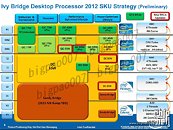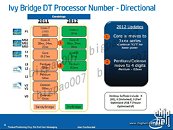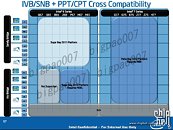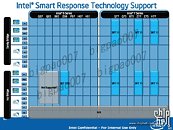Tuesday, October 18th 2011

Ivy Bridge Quad-Core to Have 77W TDP, Intel Plans for LGA1155 Ivy Bridge Entry
Intel's next generation "Ivy Bridge" Core processors slated for 2012 will mark the beginning of Intel's transition to the brand new 22 nanometer fab process. It looks like Ivy Bridge will significantly benefit from this transition, since Intel will raise the bar in terms of energy-efficiency. Even the fastest P1 (performance 1) tier quad-core chips will have TDP rated as low as 77W, down from the 95W Core i7 2600K, for example, has.
The punters at Intel marketing have sliced the market down to finer segments, to better address it. The market is sliced in terms of price-segments (vertical), and in terms of target users (horizontal). The two markers are independent of each other, yet they complement each other in pin-pointing areas of the market Intel can address. Ivy Bridge LGA1155 is restricted to P1 (performance tier 1) segment on the top, with higher tiers, along with HEDT (high-end desktop) being reserved for Sandy Bridge-E LGA2011, and future "Ivy Bridge-E". Horizontally, Intel will have "K" quad-core parts for Enthusiast, standard (locked) quad-core vPro for the Standard, "T" quad-core for Performance-optimized lifestyle, and "S" for Power-optimized lifestyle. Chaotic as it looks, the table below lays out the lineup perfectly.Unlocked "K" and standard (locked) vPro quad-core parts have TDP of 77W, performance-optimized "T" quad-core parts at 65W, and power-optimized "S" quad-core parts at 45W. There are dual-core Core i3 parts, too, with TDP of 55W (35W for the "S" variants).
The P1 segment parts will fall within the Core i7-3700 series, these chips will have the full 8 MB L3 cache present on the Ivy Bridge silicon, and 4 cores with 8 threads (HyperThreading enabled). Just below P1 segment are the MS2 and MS1 segments, the MS2 segment will include quad-core parts with 6 MB L3 cache, and no HyperThreading. The top-most MS2 part will have an unlocked multiplier, much like today's Core i5-2500K. MS2 and MS1 segment parts will take up Core i5-3500 series, Core i5-3400 series, and Core i5-3300 series. There will be just one class of dual-core parts, in the power-optimized MS1 segment. These segments will get have an updated feature-set over the present generation, that includes AES-NI acceleration, PP-DRNG.Dual-core parts will span across key low-end and value segments. The 55W dual-core silicon will form the bed for SKUs in all four horizontal segments, in T2, T1, and L3 vertical segments. T2 and T1 segment parts will carry the Core i3-3100 series SKUs. These chips will have HyperThreading technology enabled, along with AVX, and updated GPU feature-set. The L3 segment will house the cheapest Ivy Bridge processor, in the Pentium Dual-Core G2000 family. This chip will now support dual-channel DDR3-1600 MHz.
Moving on to backwards compatibility with current Intel 6-series chipset motherboards, let me kill the suspense here. Ivy Bridge will run on Intel 6-series chipset motherboards, provided:
Sources:
ChipHell, VR-Zone
The punters at Intel marketing have sliced the market down to finer segments, to better address it. The market is sliced in terms of price-segments (vertical), and in terms of target users (horizontal). The two markers are independent of each other, yet they complement each other in pin-pointing areas of the market Intel can address. Ivy Bridge LGA1155 is restricted to P1 (performance tier 1) segment on the top, with higher tiers, along with HEDT (high-end desktop) being reserved for Sandy Bridge-E LGA2011, and future "Ivy Bridge-E". Horizontally, Intel will have "K" quad-core parts for Enthusiast, standard (locked) quad-core vPro for the Standard, "T" quad-core for Performance-optimized lifestyle, and "S" for Power-optimized lifestyle. Chaotic as it looks, the table below lays out the lineup perfectly.Unlocked "K" and standard (locked) vPro quad-core parts have TDP of 77W, performance-optimized "T" quad-core parts at 65W, and power-optimized "S" quad-core parts at 45W. There are dual-core Core i3 parts, too, with TDP of 55W (35W for the "S" variants).
The P1 segment parts will fall within the Core i7-3700 series, these chips will have the full 8 MB L3 cache present on the Ivy Bridge silicon, and 4 cores with 8 threads (HyperThreading enabled). Just below P1 segment are the MS2 and MS1 segments, the MS2 segment will include quad-core parts with 6 MB L3 cache, and no HyperThreading. The top-most MS2 part will have an unlocked multiplier, much like today's Core i5-2500K. MS2 and MS1 segment parts will take up Core i5-3500 series, Core i5-3400 series, and Core i5-3300 series. There will be just one class of dual-core parts, in the power-optimized MS1 segment. These segments will get have an updated feature-set over the present generation, that includes AES-NI acceleration, PP-DRNG.Dual-core parts will span across key low-end and value segments. The 55W dual-core silicon will form the bed for SKUs in all four horizontal segments, in T2, T1, and L3 vertical segments. T2 and T1 segment parts will carry the Core i3-3100 series SKUs. These chips will have HyperThreading technology enabled, along with AVX, and updated GPU feature-set. The L3 segment will house the cheapest Ivy Bridge processor, in the Pentium Dual-Core G2000 family. This chip will now support dual-channel DDR3-1600 MHz.
Moving on to backwards compatibility with current Intel 6-series chipset motherboards, let me kill the suspense here. Ivy Bridge will run on Intel 6-series chipset motherboards, provided:
- They use the following chipsets: Z68, P67, H67, or H61 (Q67 and Q65 are not supported);
- The motherboards feature ME8L UEFI update. For this:
o Your motherboard should currently feature a UEFI firmware
o It should support ME8L update process at the physical level, where the EEPROM is sufficiently large




74 Comments on Ivy Bridge Quad-Core to Have 77W TDP, Intel Plans for LGA1155 Ivy Bridge Entry
I don't need x86 to do any of these things anymore.
-Email
-Websurfing
-Games (think Angrybirds which is now much more popular on ARM than PC)
-Videoconfrencing via skype
-Productivity software (is still in its infancy)
Hell, if I could walk up to a keyboard and monitor and wirelessly sync my phone with them I don't think I would need a PC (once MS gets their ass in gear and makes a proper ARM port of Office). The only problem right now with smartphones and tablets is the interface is sometimes not as good as the PC counterparts especially for productivity tasks. Optional sync solves this completely.
Sure some tasks require serious horsepower, but not many and rarely does the average person need it. Also, cloud processing will lend a helping hand in this respect when the time comes. This is the heavy lifting that Intel will be doing.
Anyways, its crystal clear to me. I'm surprised others don't see it.
I also got a p45 to replace the p35 i had for pci-e 2, admittedly that one wasn't necessary
Windows 8 will run on ARM.
Honestly, what part of this isn't a direct, immediate and future threat to Intel and x86?
But anyway, Ivy looks really good I think we could expect an 8 core desktop part as well...
Legacy software support can only be there for so long, if Intel and the market keep progressing for so long. The idea is, everything pretty much get's to old, and sometimes it's replaced with something completely different. (Take for instance, Steve Job's and everything he has changed drastically.)
@ the rate ARM processor's are going, there going to be very fast, fast enough to run java, encode video's, and add VM's.
What make's you think they will progress to heavy, power hogging design's where EVERYTHING in there trend is to stay small, no matter what.
ARM processor's are going to keep there market, they have to because that's what they compete the best in, there going to grow enough where they can finally address other market's with there own version's of software and compatibility.
It's like saying, ARM's will never progress, because the only thing ARM processors are not doing right now, is everything you mentioned above. Believe it when you see ARM processors with java capability's, Vm's, Encoding, Heavy gaming.
Because that's all they got left to start progressing towards.
And if anything there will be ground breaking new software that will do exactly everything you said above, for ARM processor's that's all they have to look forward to. Nothing's necessarily stopping them.
Because most gigabyte boards support dual BIOS, I could see them flashing to backup BIOS first, and then an updated EFI firmware might be possible.
And you are right, it's nothing more than a "tweaked drive controller BIOS" currently, as "address space tweak", i do not think covers how much of a hack it really is.
Consoles and PC's will continue to evolve as long as the desire for immersive escapism is there. Cloud will address some things but latency issues and down time still make it a not for fun option.
Productivity tasks again done on a small screen form are tiresome. Sometimes you need a large 15" screen to get things done.
Miniaturisation of form factor us all fine on dandy but it entirely depends upon the needs basis of the consumer.
I'm with BTA on this one. It is two different avenues that run parallel. And please note as devices become more powerful, battery life is not progressing as much so devices still do not give the operational run time of a mains powered 10kg leviathon (or 17KG as my fat desktop is!).
No, I like my bike for zipping about but when i need to take the kids and dog to the beach, I'll use my 4x4.
What's stopping those engineer's from creating an docking station, or link between wired connection to a monitor if its that fast.
See what you guy's are forgetting is, ARM processor's have no limitation's, what's stopping it from communicating with a big monitor via any type of connection.
There are no limitation's to ARM processor's.
I could see in the future, devices so powerful it is literally a computer in your pocket, and if the user wanted to have more capability's he can connect that device dock/wire/wireless to a bigger panel.....
Imagine the portable platform, when you do not need that big platform, you can remove the device and take it on the go like a psp, something so intertwined with you it compete's in multiple market's.
Nothing is stopping ARM processor's, and there continued innovation to be faster, more portable, and reliable to the consumer, its open....
**EDIT** With battery life, there are limitation's on how fast that progresses, but with all this hogging of Non-renewable resource's, were eventually going to really have to rely on batteries.
Eventually there will be enough of a movement and innovation that we will eventually master the art of saving electricity, because if we dont.
Were going to in the dark age's very very soon.
Still would reduce this to 3 levels. (high - mid - low) and having max 3 or 4 cpu's per level.
12 cpu models vs 128 cpu models should cut down on time + money wasted and Intel running around like a headless chicken that Intel used to be.
Laptop should have max 3 or 4 cpu's in total, embedded / Atom 4x at max products.
Laptop and low power can be merged as they share same concepts except.
Would be ideal if desktop and server could be the same where server has the cherry on the cake or just extra cache or some extra featured using the same base / actual desktop cpu model.
This can then share same sockets and those with the cash can use the server cpu's in their desktops if they have the cash or high end motherboards that allow this.
ARM processors still have a long way to go before they can compete with the likes of even a low-end Sandy Bridge processor.
Laptops and nettops wouldn't outsell desktops, etc.
If ARM can grab the entire non-gaming, non-enthusiast, non-workstation market Intel could still easily loose 80% of their consumer market. Sure that's not going to happen anytime soon, but even a 15% loss would completely change the landscape and would make them have to cut some corners in the company. Add the fact that they also compete with their own previous generations* and Intel could be facing some real challenges in the near future.
* Like I said any Quad from the past 4 years is enough for 95% of the people. Also most people expect their PCs to last more than 5 years. These people who are buying PCs right now will not be willing to buy anything for the next 5-8 years, because they trully don't need it. If by 2015 ARM can put out octo+ cores, that are out of order and can reach 4 Ghz, that will be a good enough upgrade for them. Cortex A-15 is already OoO superscalar and is expected to come in at 2.5 Ghz. So what I said above is more than doable, hence it would all become a matter of price, wattage etc. and there ARM is a much better contender. Not that Intel could not contend in that situation, but it would need to become a much more "slim" company in order to be able to be sustained selling $10-$50 chips intead of current ones.